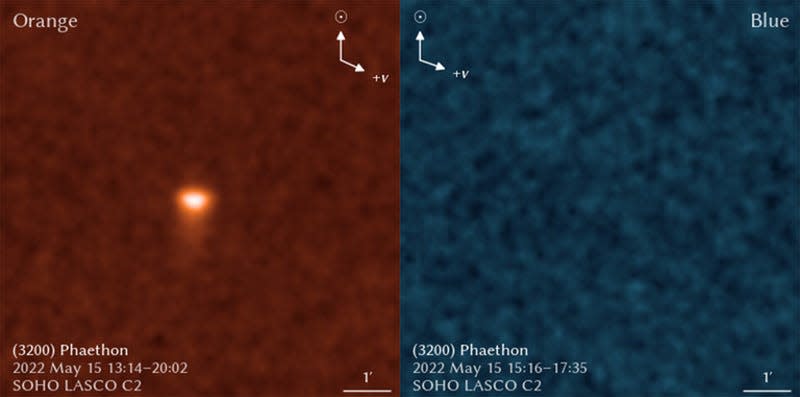
Astonishing new observations of the enigmatic asteroid Phaethon have revealed that it is displaying comet-like behavior. However, unlike typical comets that produce a tail of dust, Phaethon is emitting a tail of sodium as it approaches the Sun. The Solar and Heliospheric Observatory (SOHO), a joint project between NASA and the European Space Agency, captured these new images of Phaethon as it made its way near the Sun in May 2022. Using different filters, the Large Angle and Spectrometric Coronagraph (LASCO) on board SOHO detected the presence of sodium in the asteroid's tail, whereas the blue filter that detects dust didn't reveal any such thing.
According to a new paper published in the Planetary Science Journal, this suggests that the tail is made up of sodium atoms rather than dust escaping from the surface during its flyby of the Sun. To confirm their findings, the researchers behind the study went through old SOHO data and found images of Phaethon dating back more than two decades. This is the first time the asteroid has been detected in SOHO data.

Phaethon's behavior is not entirely understood. Although it is classified as an asteroid, it displays some comet-like traits. In 2009, NASA's Solar Terrestrial Relations Observatory (STEREO) discovered a short tail that appeared behind the asteroid during its closest approach to the Sun. The rock is also believed to be the source of the Geminid meteor shower that appears in December each year. This is unusual since most meteor showers are associated with comets.
The latest observations of the asteroid's sodium tail could provide new insight into the origin of the Geminid meteor shower. Previously, scientists had believed that the asteroid's tail produced the meteor shower, but the recent findings suggest otherwise. The researchers behind the new study propose that a piece of Phaethon broke off several thousand years ago, which led to the ejection of billions of small bits that make up the Geminids.
In 2028, the Japanese space agency is planning to send the DESTINY+ mission to Phaethon to capture more images of its surface. The new observations of Phaethon have left scientists with more questions than answers, adding to the mystery surrounding this unusual object.

0 Comments
Any Queries , You May Ask